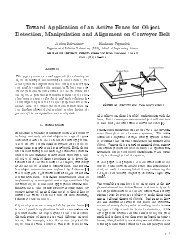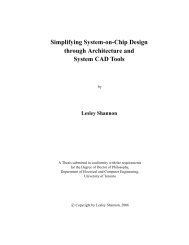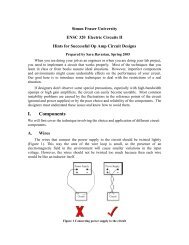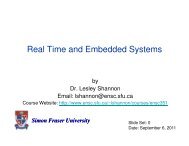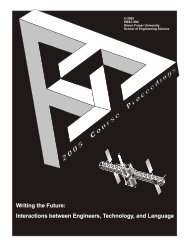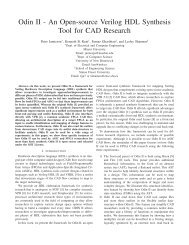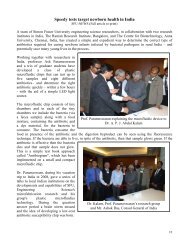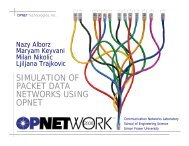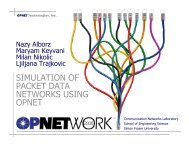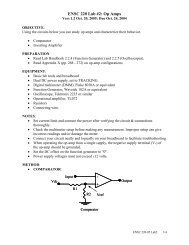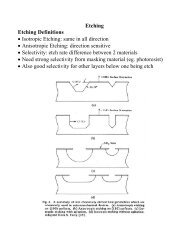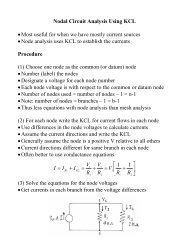I the,art in trellis-coded modulation
I the,art in trellis-coded modulation
I the,art in trellis-coded modulation
Create successful ePaper yourself
Turn your PDF publications into a flip-book with our unique Google optimized e-Paper software.
I<br />
n this second p<strong>art</strong> [ 11, a synopsis of <strong>the</strong> present state of<br />
I <strong>the</strong>,<strong>art</strong> <strong>in</strong> <strong>trellis</strong>-<strong>coded</strong> <strong>modulation</strong> (TCM) is given for<br />
<strong>the</strong> more <strong>in</strong>terested reader. First, <strong>the</strong> general structure of<br />
TCM schemes and <strong>the</strong> pr<strong>in</strong>ciples of code construction<br />
are reviewed. Next, <strong>the</strong> effects of carrier-phase offset <strong>in</strong><br />
carrier-modulated TCM systems are discussed. The topic<br />
is important, s<strong>in</strong>ce TCM schemes turn out to be more<br />
sensitive to phase offset than un<strong>coded</strong> <strong>modulation</strong><br />
systems. Also, TCM schemes are generally not phase<br />
<strong>in</strong>variant to <strong>the</strong> same extent as <strong>the</strong>ir signal sets. F<strong>in</strong>ally,<br />
recent advances <strong>in</strong> TCM schemes that use signal sets<br />
def<strong>in</strong>ed <strong>in</strong> more than two dimensions are described, and<br />
o<strong>the</strong>r work related to <strong>trellis</strong>-<strong>coded</strong> <strong>modulation</strong> is mentioned.<br />
The best codes currently known for one-, two-,<br />
four-, and eight-dimensional signal sets are given <strong>in</strong> an<br />
Appendix.<br />
Design of Trellis-Coded<br />
Modulation Schemes<br />
The <strong>trellis</strong> structure of <strong>the</strong> early hand-designed TCM<br />
schemes and <strong>the</strong> heuristic rules used to assign signals to<br />
<strong>trellis</strong> transitions suggested that TCM schemes should<br />
have an <strong>in</strong>terpretation <strong>in</strong> terms of convolutional codes<br />
with a special signal mapp<strong>in</strong>g. This mapp<strong>in</strong>g should be<br />
based on group<strong>in</strong>g signals <strong>in</strong>to subsets with large<br />
distance between <strong>the</strong> subset signals. Attempts to expla<strong>in</strong><br />
TCM schemes <strong>in</strong> this manner led to <strong>the</strong> general structure<br />
of TCM encoders/modulators depicted <strong>in</strong> Fig. 1. Accord<strong>in</strong>g<br />
to this figure, TCM signals are generated as follows:<br />
When m bits are to be transmitted per encoder/modulator<br />
operation, m 5 m bits are expanded by a rate-rYd(m -t 1)<br />
b<strong>in</strong>ary convolutional encoder <strong>in</strong>to rii -t 1 <strong>coded</strong> bits.<br />
These bits are used to select one of 2‘“ + subsets of a<br />
redundant 2’11+1-ary signal set. The rema<strong>in</strong><strong>in</strong>g m - m<br />
un<strong>coded</strong> bits determ<strong>in</strong>e which of <strong>the</strong> 2”’-’” signals <strong>in</strong> this<br />
subset is to be transmitted.<br />
Set P<strong>art</strong>ition<strong>in</strong>g<br />
The concept of set p<strong>art</strong>ition<strong>in</strong>g is of central significance<br />
for TCM schemes. Figure 2 shows this concept for a<br />
32-CROSS signal set [ 11, a signal set of lattice type “Z2”.<br />
Generally, <strong>the</strong> notation “Zk” is used to denote an <strong>in</strong>f<strong>in</strong>ite<br />
“lattice” of po<strong>in</strong>ts <strong>in</strong> k-dimensional space with <strong>in</strong>teger<br />
coord<strong>in</strong>ates. Lattice-type signal sets are f<strong>in</strong>ite subsets of<br />
lattice po<strong>in</strong>ts, which are centered around <strong>the</strong> orig<strong>in</strong> and<br />
have a m<strong>in</strong>imum spac<strong>in</strong>g of A,.<br />
Set p<strong>art</strong>ition<strong>in</strong>g divides a signal set successively <strong>in</strong>to<br />
smaller subsets with maximally <strong>in</strong>creas<strong>in</strong>g smallest<br />
<strong>in</strong>tra-set distances A;, i = 0,1, ... . Each p<strong>art</strong>ition is<br />
two-way. The p<strong>art</strong>ition<strong>in</strong>g is repeated iii 4- 1 times until<br />
A,,+, is equal to or greater than <strong>the</strong> desired free distance of<br />
<strong>the</strong> TCM scheme to be designed. The f<strong>in</strong>ally obta<strong>in</strong>ed<br />
subsets, labeled DO, Dl, ... D7 <strong>in</strong> <strong>the</strong> case of Fig. 2, will<br />
henceforth be referred to as <strong>the</strong> “subsets.”The label<strong>in</strong>g of<br />
branches <strong>in</strong> <strong>the</strong> p<strong>art</strong>ition tree by <strong>the</strong> fi -t 1 <strong>coded</strong> bits z:“,<br />
..., z:, <strong>in</strong> <strong>the</strong> order as shown <strong>in</strong> 2, Fig. results <strong>in</strong> a label z,,<br />
-<br />
[z::, ... zt] for each subset. The label reflects <strong>the</strong> position<br />
of <strong>the</strong> subset <strong>in</strong> <strong>the</strong> tree.<br />
This label<strong>in</strong>g leads to an important property. If <strong>the</strong><br />
labels of two subsets agree <strong>in</strong> <strong>the</strong> last q positions, but not<br />
<strong>in</strong> <strong>the</strong> bit z:!, <strong>the</strong>n <strong>the</strong> signals of <strong>the</strong> two subsets are<br />
12 0163-6804/87/0002-0012 sO1.00 @ 1987 IEEE
m<br />
x; ;j<br />
m-iii<br />
SIGNAL<br />
MAPPING<br />
where (e_,,) denotes <strong>the</strong> error sequence by which <strong>the</strong>se<br />
sequences differ. S<strong>in</strong>ce <strong>the</strong> convolutional code is l<strong>in</strong>ear,<br />
{e,,} is also a code sequence. It follows from <strong>the</strong> "setp<strong>art</strong>ition<strong>in</strong>g<br />
lemma" mentioned <strong>in</strong> <strong>the</strong> preced<strong>in</strong>g subsection<br />
and <strong>the</strong> "rate-fi/(fi + 1) code lemma" that <strong>the</strong><br />
squared free distance between non-parallel paths <strong>in</strong> <strong>the</strong><br />
TCM <strong>trellis</strong> is bounded by [2]<br />
Fig. I . Genernl structure of encoderlmodulalor for trellzs-<strong>coded</strong><br />
modulalzon.<br />
elements of <strong>the</strong> same subset at level q <strong>in</strong> <strong>the</strong> p<strong>art</strong>ition tree;<br />
thus <strong>the</strong>y have at least distance A
as follows. For 4AM, 8-AM, ... (signal sets of type “Z,’’),<br />
Ai+, = ZA,, i = 0.1, ... . For 16-QASK 32-CROSS, ...<br />
=&A~, i = 0,1, ... .<br />
(signal sets of lattice type “z,”), ni+,<br />
The non-lattice type signal sets 8-PSK and 16-PSK have<br />
special sequences of <strong>in</strong>tra-set distances. The <strong>in</strong>tra-set<br />
distances for higher-dimensional signal sets will be<br />
given when multi-dimensional TCM schemes are discussed<br />
later <strong>in</strong> this <strong>art</strong>icle.<br />
For a given sequence of m<strong>in</strong>imum <strong>in</strong>tra-set distances<br />
A, 4 A, 4 ... A,,, and a chosen value of u, a convolutional<br />
code with <strong>the</strong> largest possible value of dcrrv(r%) can be<br />
found by a code-search program described <strong>in</strong> [Z]. The<br />
program performs <strong>the</strong> search for <strong>the</strong> (v + 1) (6 + 1)<br />
b<strong>in</strong>ary parity-check coefficients <strong>in</strong> a p<strong>art</strong>icular order and<br />
with a set of code-rejection rules such that explicit checks<br />
on <strong>the</strong> value of dCnl(r%) are very frequently avoided.<br />
Tables of optimum codes for one-, two-, four-, and<br />
eight-dimensional TCM schemes are shown <strong>in</strong> <strong>the</strong><br />
Appendix. Parity-check coefficients are specified <strong>in</strong> octal<br />
form, for example, [hg, ... , h!] = [1,0,0,0,1,0,1] is written<br />
as bo = 105x. Equivalent codes <strong>in</strong> terms of free distance<br />
will be obta<strong>in</strong>ed if <strong>the</strong> parity-check coefficients of h‘ are<br />
added modulo-2 to <strong>the</strong> coefficients of,bk, for i > k [Z]. If<br />
A; = A,, hi and hh may also be <strong>in</strong>terchanged. When <strong>in</strong> <strong>the</strong><br />
code tables <strong>the</strong> free distance of a code is marked by an Fig. 3. Two encoders for a l<strong>in</strong>ear 8-slale conuolulronal code wilh<br />
asterisk (*), df,,,,,(m) exceeds A,,+, ,and hence <strong>the</strong> free distance parily-check coefficients h’ = [O,l,O,O], b’ = [O,O,l,O], bo =[l,O,O,l]<br />
occurs only between <strong>the</strong> subset signals assigned to (cf. Tables I1 and III <strong>in</strong> ihe Appendix)., (a) M<strong>in</strong>imal syslemalzc<br />
parallel transitions. These schemes have <strong>the</strong> smallest<br />
encoder with feedback. (b) M<strong>in</strong>zmal feedback-free encoder.<br />
numbers of nearest neighbors. For example, <strong>the</strong> 256-state<br />
code for “ZI”-type signals has this property. For large<br />
values of m, this code atta<strong>in</strong>s a full 6 dB cod<strong>in</strong>g ga<strong>in</strong> with<br />
only two nearest neighbors.<br />
ensures that at time n <strong>the</strong> un<strong>coded</strong> bits have no <strong>in</strong>fluenc<br />
on <strong>the</strong> bit z!, nor on <strong>the</strong> <strong>in</strong>put to <strong>the</strong> first b<strong>in</strong>ary storage<br />
Two Encoder Realizations<br />
element <strong>in</strong> <strong>the</strong> encoder. Hence, whenever <strong>in</strong> <strong>the</strong> code<br />
<strong>trellis</strong> two paths diverge from or merge <strong>in</strong>to a common<br />
The parity-check equation specifies only <strong>the</strong> convolustate,<br />
<strong>the</strong> bit z! must be <strong>the</strong> same for <strong>the</strong>se transitions,<br />
tional code. Encoders for <strong>the</strong> same code can differ <strong>in</strong> <strong>the</strong><br />
whereas <strong>the</strong> o<strong>the</strong>r bits differ <strong>in</strong> at least one bit. Signals<br />
<strong>in</strong>put/output relation which <strong>the</strong>y realize. Figure 3<br />
associated with diverg<strong>in</strong>g and merg<strong>in</strong>g transitions<br />
illustrates two encoders for <strong>the</strong> 8-state l<strong>in</strong>ear code<br />
<strong>the</strong>refore have at least distance A, between <strong>the</strong>m, which<br />
specified <strong>in</strong> Tables I1 and I11 (v = 3) <strong>in</strong> <strong>the</strong> Appendix.<br />
reflects <strong>the</strong> second heuristic rule for good TCM codes<br />
One is called a systematic encoder with feedback, <strong>the</strong><br />
mentioned <strong>in</strong> P<strong>art</strong> I [l].<br />
o<strong>the</strong>r a feedback-free encoder. Both encoders are m<strong>in</strong>imal,<br />
TCM schemes for twoidimensional carrier <strong>modulation</strong><br />
that is, <strong>the</strong>y are realized with v b<strong>in</strong>ary storage elements.<br />
(with 8-PSK signal setsand “Z1”-type signal sets) up have<br />
The transformation of one m<strong>in</strong>imal encoder <strong>in</strong>to <strong>the</strong><br />
to <strong>the</strong> present time attracted <strong>the</strong> most attention. Practical<br />
o<strong>the</strong>r follows from <strong>the</strong> structural properties of convolurealizations<br />
of <strong>the</strong>se systems <strong>in</strong>dicated that <strong>the</strong> effects of<br />
tional codes described <strong>in</strong> [3]. With a systematic encoder,<br />
transmission impairments o<strong>the</strong>r than additive Gaussian<br />
<strong>the</strong> <strong>in</strong>put bits appear unchanged at <strong>the</strong> output. Therefore,<br />
noise on <strong>the</strong>ir performance need to be studied, <strong>in</strong><br />
a systematic encoder cannot generate a catastrophic code,<br />
p<strong>art</strong>icular those of carrier offset.<br />
i.e., a code with no distance <strong>in</strong>crease between two <strong>trellis</strong><br />
paths that rema<strong>in</strong> dist<strong>in</strong>ct for an unbounded length.<br />
Effects of Carrier-Phase Offset<br />
This is also true, although far from be<strong>in</strong>g obvious, for an<br />
equivalent m<strong>in</strong>imal feedback-free encoder [3].<br />
This section addresses <strong>the</strong> problems that arise when a<br />
The forward and backward connections <strong>in</strong> <strong>the</strong> syste- carrier-modulated two-dimensional TCM signal is dematic<br />
encoder are specified by <strong>the</strong> parity-check coeffi- modulated with a phase offset A4. The soft-decision<br />
cients of <strong>the</strong> code. All codes presented <strong>in</strong> <strong>the</strong> Appendix decoder <strong>the</strong>n operates on a sequence of complex-valued<br />
have hjj = h: = 1. This guarantees <strong>the</strong> realizability of an signals {r,,} = {a,, . exp(jA4) + wn}, where <strong>the</strong> a,, are<br />
encoder <strong>in</strong> <strong>the</strong> form shown <strong>in</strong> Fig. 3a. The reader transmitted TCM signals and <strong>the</strong> w,, denote additive<br />
familiar with recursive digital filters will see that <strong>the</strong> Gaussian noise. The phase offset A4 could be caused, for<br />
parity-check equation is used (almost directly) to <strong>in</strong>stance, by disturbances of <strong>the</strong> carrier phase of <strong>the</strong><br />
compute <strong>the</strong> bit z! from <strong>the</strong> o<strong>the</strong>r un<strong>coded</strong> bits. received signal which <strong>the</strong> phase-track<strong>in</strong>g scheme of <strong>the</strong><br />
Fur<strong>the</strong>rmore, all codes have ht = h;, = 0, for i > 0. This receiver cannot track <strong>in</strong>stantly.<br />
-11<br />
,<br />
February 1987-Vol. 25, No. 2<br />
IEEE Communications Magaz<strong>in</strong>e<br />
14
dB<br />
Fig. 4.<br />
0" 22.5" 45"<br />
Carrier- phase offset A@<br />
Error performance of <strong>coded</strong> 8-PSK and un<strong>coded</strong> 4-PSK <strong>in</strong><br />
<strong>the</strong> presence of carrier-phase offset Ab.<br />
I<br />
I<br />
I<br />
I<br />
I<br />
I<br />
I<br />
I<br />
I<br />
I<br />
I<br />
I<br />
I<br />
I<br />
Performance Degradation<br />
rotations under which <strong>the</strong> signal set is phase <strong>in</strong>variant.<br />
Figure 5 <strong>in</strong>dicates a phase symmetry of 4-state <strong>coded</strong><br />
The error performance of 4-state and 8-state <strong>coded</strong> 8-PSK only at A4 = 180". but not at o<strong>the</strong>r multiples of<br />
8-PSK systems <strong>in</strong> <strong>the</strong> presence of phase offset (based on 45". This symmetry can be verified by <strong>in</strong>spection of <strong>the</strong><br />
unpublished work) is illustrated <strong>in</strong> Fig. 4. The figure code <strong>trellis</strong> presented <strong>in</strong> Fig. 2b of P<strong>art</strong> I [ 11. Coded 8-PSK<br />
shows <strong>the</strong> signal-to-noise ratio needed to susta<strong>in</strong> an schemes which are <strong>in</strong>variant to phase shifts of all<br />
error-event probability of lo-' as a function of A+. For multiples of 45" have been found [4], but <strong>the</strong>se schemes<br />
<strong>the</strong> <strong>coded</strong> 8-PSK systems, <strong>the</strong> required signal-to-noise require more than four states to achieve a cod<strong>in</strong>g ga<strong>in</strong> of<br />
ratio <strong>in</strong>creases with <strong>in</strong>creas<strong>in</strong>g values of A+ until both 3 dB.<br />
systems fail at A4 = 22.5", even <strong>in</strong> <strong>the</strong> absence of noise. In In general, is it desirable that TCM codes have as many<br />
contrast, un<strong>coded</strong> 4-PSK requires a higher signal-to- phase symmetries as possible to ensure rapid carriernoise<br />
ratio at small phase offsets, but has an operat<strong>in</strong>g phase resynchronization after temporary loss of synrange<br />
up to A4 = 45" <strong>in</strong> <strong>the</strong> absence of noise. These chronization. On <strong>the</strong> o<strong>the</strong>r hand, such phase <strong>in</strong>variances<br />
results are typical for TCM schemes.<br />
must be made transparent to <strong>the</strong> transmitted user<br />
The greater susceptibility of TCM schemes to phase<br />
offset can be expla<strong>in</strong>ed as follows. In <strong>the</strong> <strong>trellis</strong> diagrams<br />
of TCM schemes, <strong>the</strong>re exist long dist<strong>in</strong>ct paths with low<br />
growth of signal distance between <strong>the</strong>m, that is, paths f<br />
which have ei<strong>the</strong>r <strong>the</strong> same signals or signals with<br />
smallest distance A,, assigned to concurrent transitions.<br />
In <strong>the</strong> absence of phase offset, <strong>the</strong> non-zero squared<br />
distances Ai and <strong>the</strong> squared larger distances of diverg<strong>in</strong>g<br />
or merg<strong>in</strong>g transitions add to up at least <strong>the</strong> squared free<br />
distance. However, if phase offset rotates <strong>the</strong> received<br />
signals such that received signals become located<br />
'-I<br />
halfway between <strong>the</strong> signals of <strong>the</strong> orig<strong>in</strong>al signal set, <strong>the</strong><br />
difference <strong>in</strong> distance between received signals and <strong>the</strong><br />
signals on dist<strong>in</strong>ct transitions that are A,, ap<strong>art</strong> may be<br />
reduced to zero. There may <strong>the</strong>n be no difference <strong>in</strong><br />
(S- curve) !J<br />
distance between a long segment of received signals and<br />
two dist<strong>in</strong>ct <strong>trellis</strong> paths, just as though <strong>the</strong> code were<br />
catastrophic. At this po<strong>in</strong>t, <strong>the</strong> decoder beg<strong>in</strong>s to fail.<br />
Behauior of Carrier-Phase Track<strong>in</strong>g Loops<br />
Nowadays, <strong>in</strong> most digital carrier-<strong>modulation</strong> systems,<br />
decision-directed loops are employed for carrier-phase<br />
track<strong>in</strong>g. In <strong>the</strong>se loops, <strong>the</strong> phase offset is estimated<br />
from <strong>the</strong> received signal and <strong>the</strong> decoder decisions. The<br />
estimated phase offset controls <strong>the</strong> demodulat<strong>in</strong>g carrier<br />
phase. In a TCM receiver, if <strong>the</strong> phase offset exceeds a<br />
critical value, for example, 22.5" <strong>in</strong> <strong>the</strong> case of <strong>coded</strong><br />
8-PSK, <strong>the</strong> decoder decisions become essentially uncorrelated<br />
with <strong>the</strong> received signal and <strong>the</strong> mean value of <strong>the</strong><br />
phase estimate drops to zero. Figure 5 illustrates, for<br />
4-state <strong>coded</strong> 8-PSK [Z], <strong>the</strong> mean estimate of A4 ("Scurve")<br />
and its variance as a function of <strong>the</strong> actual value<br />
of <strong>the</strong> phase offset. A vanish<strong>in</strong>g mean estimate, as occurs<br />
for A4 between 22.5" and 157.5", leaves <strong>the</strong> carrier-phase<br />
track<strong>in</strong>g loop <strong>in</strong> an undriven random-walk situation<br />
which can last for long periods. Eventually, <strong>the</strong> system<br />
resynchronizes when <strong>the</strong> randomly-fluctuat<strong>in</strong>g demodulat<strong>in</strong>g<br />
carrier phase approaches a value for which <strong>the</strong><br />
received signal aga<strong>in</strong> resembles a valid TCM sequence.<br />
This behavior is <strong>in</strong> significant contrast to <strong>the</strong> short phase<br />
skips and rapid recovery observed <strong>in</strong> un<strong>coded</strong> 4-PSK or<br />
8-PSK systems. It suggests that <strong>in</strong> some cases TCM<br />
systems may require special methods to force rapid<br />
resynchronization.<br />
Inuariance of Two-Dimensional TCM Codes<br />
under Phase Rotation<br />
TCM codes are not usually <strong>in</strong>variant to all phase<br />
I l l l l l l l l l l l l l l l<br />
-45" 0" 45" 90" 135" 180" 225" A@<br />
Fig. 5. Mean ("S-curve") and variance of <strong>the</strong> estzmated phase offset<br />
A$ <strong>in</strong> a decision-dzrecled carrier-phase track<strong>in</strong>g loop for ./-.slate<br />
<strong>coded</strong> 8-PSK versus <strong>the</strong> actual phase offset A+, at a signal-to-noise<br />
ratio of 13 dB (tentative decisions used with zero delay).<br />
15<br />
February 1987-Vol. 25, No. 2<br />
IEEE Communications Magaz<strong>in</strong>e
~<br />
~<br />
4 4<br />
ENCODER NONLINEAR CONVOLUTIONAL ENCODER<br />
NUMBER BENEATH SIGNAL<br />
ON10 l0lW 01010<br />
Fig. 6. Nonlrnear 8-stale encoderlmodulator with 32-CROSS signal<br />
.ret and dijjerentral encod<strong>in</strong>g, as <strong>in</strong> CCZTT Recomnzendalzon V.32.<br />
<strong>the</strong> CCITT V.33 Draft Recommendation [8, P<strong>art</strong> I], but<br />
with 64-QASK and 128-CROSS signal sets (m = 5,6). In<br />
<strong>the</strong> limit of large signal sets, <strong>the</strong> number of nearest<br />
neighbors <strong>in</strong> <strong>the</strong> 8-state l<strong>in</strong>ear and <strong>the</strong> CCITT nonl<strong>in</strong>ear<br />
code is 16.<br />
In a late contribution to <strong>the</strong> CCITT [7], illustrated <strong>in</strong><br />
Fig. 7, an alternative 8-state nonl<strong>in</strong>ear encoder with <strong>the</strong><br />
differential-encod<strong>in</strong>g function <strong>in</strong>tegrated <strong>in</strong>to <strong>the</strong> encoder<br />
was proposed. The cod<strong>in</strong>g ga<strong>in</strong> and <strong>the</strong> number of<br />
nearest neighbors are identical to those of <strong>the</strong> o<strong>the</strong>r 8-<br />
state schemes. The <strong>trellis</strong> diagram of <strong>the</strong> alternative<br />
nonl<strong>in</strong>ear code was shown <strong>in</strong> Fig. 6 of P<strong>art</strong> I [I].<br />
Differential decod<strong>in</strong>g requires that <strong>the</strong> receiver compute<br />
x,', = z:', CB z!+, . Subsets are labeled as <strong>in</strong>dicated <strong>in</strong> Fig. 2.<br />
The selection of signals with<strong>in</strong> <strong>the</strong> subsets by <strong>the</strong><br />
un<strong>coded</strong> bits x,', , x: is worth mention<strong>in</strong>g. If x:, = 0, only<br />
signals of <strong>the</strong> <strong>in</strong>ner 16-QASK set are transmitted (m =3).<br />
With non-zero values of x:,, outer signals of <strong>the</strong> larger<br />
32-CROSS set are also selected (In =4). Extension of this<br />
concept to larger signal sets resulted <strong>in</strong> one general<br />
signal mapp<strong>in</strong>g for all data rates, e.g., for 35 m 5 7 [7].<br />
The mapp<strong>in</strong>g has <strong>the</strong> additional property it that can just<br />
as well be used for un<strong>coded</strong> <strong>modulation</strong> with modulo-4<br />
differential encod<strong>in</strong>g of <strong>the</strong> bits zf,, zii.<br />
The nonl<strong>in</strong>ear 8-state TCM codes appear to be special<br />
cases. Similar nonl<strong>in</strong>ear phase-<strong>in</strong>variant codes with 16<br />
and more states can be constructed. However, at least for<br />
16 states, it does not seem possible to f<strong>in</strong>d a code with <strong>the</strong><br />
same 4.8 dB cod<strong>in</strong>g ga<strong>in</strong> as can be obta<strong>in</strong>ed with a l<strong>in</strong>ear<br />
code.<br />
<strong>in</strong>formation by some fo.rm of differential encod<strong>in</strong>g and<br />
decod<strong>in</strong>g. If loss of phase synchronization is very<br />
unlikely, one may argue that TCM codes without phase<br />
<strong>in</strong>variances may have <strong>the</strong> advantage that receiver <strong>the</strong> can<br />
establish absolute phase from <strong>the</strong> received signal, so that<br />
no differential encod<strong>in</strong>g/decod<strong>in</strong>g is required.<br />
The problems of phase <strong>in</strong>variance and differential<br />
encod<strong>in</strong>g/decod<strong>in</strong>g attracted considerable attention <strong>in</strong><br />
work toward a TCM code for use <strong>in</strong> CCITT Recommendations<br />
for voice-band modems operat<strong>in</strong>g full-duplex at<br />
up to 9.6 kbit/s over two-wire telephone circuits, and at<br />
up to 14.4 kbit/s over four-wire circuits. There was<br />
considerable <strong>in</strong>terest <strong>in</strong> a two-dimensional 8-state code<br />
that can achieve, with 90"-symmetric QASKand CROSS<br />
signal sets, a cod<strong>in</strong>g ga<strong>in</strong> of about 4 dB over un<strong>coded</strong><br />
<strong>modulation</strong>. With <strong>the</strong> known l<strong>in</strong>ear code (cf. Table 111 <strong>in</strong><br />
<strong>the</strong> Appendix, v = 3), it was only possible (by add<strong>in</strong>g<br />
parity-check coefficients <strong>in</strong> way a which does not change<br />
0 0 0 0<br />
free distance, as mentioned <strong>in</strong> <strong>the</strong> subsection on<br />
11010 11111 10110 10011<br />
__<br />
optimum-code search) to have ei<strong>the</strong>r no phase symmetry<br />
0 0 0 0<br />
or a symmetry 180" at [5], [4, P<strong>art</strong> I]. A breakthrough was<br />
loo00 01001 OllOO OOIOl 01000 11001<br />
f<strong>in</strong>ally accomplished by L.F. Wei, who <strong>in</strong>troduced<br />
0 0 0 0<br />
IOlll 00110 OOOlI 00010 01111 11110<br />
nonl<strong>in</strong>ear elements <strong>in</strong>to <strong>the</strong>convolutional encoder of <strong>the</strong><br />
8-state code. This made <strong>the</strong> code <strong>in</strong>variant to 90"<br />
0 0 0 0 0<br />
11100 01101 00000 00001 00100 10101<br />
rotations while ma<strong>in</strong>ta<strong>in</strong><strong>in</strong>g its cod<strong>in</strong>g ga<strong>in</strong> of 4 dB [6],<br />
[5, P<strong>art</strong> I]. Figure 6 shows <strong>the</strong> result<strong>in</strong>g encoder/modu-<br />
0 0 0 0<br />
IlOIl 01010 Nlll 01110 OlOll 10010<br />
lator with its differential encoder, nonl<strong>in</strong>ear convo-<br />
0 0 0 0<br />
lutio'nal encoder, and signal mapp<strong>in</strong>g for a 32-CROSS<br />
10001 IOloD 11101 11000<br />
signal set (m = 4), as f<strong>in</strong>ally adopted <strong>in</strong> <strong>the</strong> CCITT V.32<br />
Recommendation [7, P<strong>art</strong> I]. The label<strong>in</strong>g of subsets Fzg. 7. Allerncctiue nonlrnear 8-stutc encoderlrnodulator<br />
differs slightly from that <strong>in</strong>dicated <strong>in</strong> Fig. 2, but <strong>the</strong><br />
subsets are <strong>the</strong> same. The same code was also chosen for<br />
NUMBER BENEATH SIGNAL:<br />
with <strong>in</strong>k-<br />
,gruted differential encod<strong>in</strong>g and gerzerctl siguul mapp<strong>in</strong>g for Ih-<br />
QASK. 32-CROS.S, etc., .signal sets.<br />
February 1987-Vol. 25, No. 2<br />
IEEE Communications Magaz<strong>in</strong>e
Multi-Dimensional Trellis Codes<br />
Recently, <strong>the</strong>re have been a number of <strong>in</strong>vestigations<br />
<strong>in</strong>to <strong>trellis</strong> cod<strong>in</strong>g with signal sets def<strong>in</strong>ed <strong>in</strong> more than<br />
two dimensions [3, P<strong>art</strong> I], [8-111. In practical systems,<br />
multi-dimensional signals can be transmitted as sequences<br />
of constituent one- or two-dimensional (I-D or<br />
2-D) signals. In this section, 2K-D TCM schemes are<br />
considered which transmit m bits per constituent 2-D<br />
signal, and hence mK bits pcr2K-D signal. The pr<strong>in</strong>ciple<br />
of us<strong>in</strong>g a redundant signal set of twice <strong>the</strong> size needed for<br />
un<strong>coded</strong> <strong>modulation</strong> is ma<strong>in</strong>ta<strong>in</strong>ed. Thus, 2K-D TCM<br />
schemes use 2‘;”’+’-ary sets of 2K-D signals. Compared to<br />
2-D TCM schemes, this results <strong>in</strong> less signal redundancy<br />
<strong>in</strong> <strong>the</strong> constituent 2-D signal sets.<br />
For 2-D TCM schemes with “Z,”-type signal sets, <strong>the</strong><br />
m<strong>in</strong>imum signal spac<strong>in</strong>g A,, must be reduced by<br />
approximately <strong>the</strong> factor a(- 3 dB) to have <strong>the</strong> same<br />
average signal power as for un<strong>coded</strong> <strong>modulation</strong>. This<br />
loss <strong>in</strong> signal spac<strong>in</strong>g needs to be more than compensated<br />
for by cod<strong>in</strong>g to obta<strong>in</strong> an overall improvement <strong>in</strong> free<br />
distance. The lower signal redundancy of multi-dimensional<br />
TCM schemes with “ZYn”-type signal sets results<br />
only <strong>in</strong> a reduction of <strong>the</strong> m<strong>in</strong>imum signal spac<strong>in</strong>g by<br />
<strong>the</strong> 2K-th root of 2 (-1.5 dB for K =2; and - 0.75 dB for K<br />
= 4), so cod<strong>in</strong>g has to contribute less than <strong>in</strong> <strong>the</strong> case of<br />
2-D TCM to obta<strong>in</strong> <strong>the</strong> same ga<strong>in</strong> <strong>in</strong> free distance. The<br />
larger signal spac<strong>in</strong>g should also make multi-dimensional<br />
TCM systems less sensitive to phase offset.<br />
F<strong>in</strong>ally, it has been found that multi-dimensional TCM<br />
schemes with 90’ phase <strong>in</strong>variance can be obta<strong>in</strong>ed with<br />
l<strong>in</strong>ear codes.<br />
Four-Dimensional Trellis-Coded Modulation<br />
The 4-D TCM schemes (K = 2) described <strong>in</strong> this<br />
subsection employ compact sets of 2‘“‘+’ signals chosen<br />
from a lattice of type “Z,” with m<strong>in</strong>imum signal spac<strong>in</strong>g<br />
A,,. Figure 8 illustrates <strong>the</strong> set p<strong>art</strong>ition<strong>in</strong>g of a signal set<br />
A‘: of type “Z,”. The, general idea is to derive <strong>the</strong> set<br />
p<strong>art</strong>ition<strong>in</strong>g of a higher-dimensional signal set from <strong>the</strong><br />
sct p<strong>art</strong>ition<strong>in</strong>gof constituent lower-dimensional signal<br />
sets. In <strong>the</strong> present case, A‘: and its subsets arc characterized<br />
by twoconstituent “Z,”-type signal sets A0 and <strong>the</strong>ir<br />
AO”A$ ‘2; n,<br />
SIGNAL<br />
MAPPI~G<br />
subsets, such as <strong>in</strong>troduced <strong>in</strong> Fig. 2. This leads to a<br />
p<strong>art</strong>ition tree with signal sets of types “Z,”- “D.1” -<br />
“Z,” 4 “D.,” - “Z,”, etc., with m<strong>in</strong>imum <strong>in</strong>tra-set<br />
distancesAo,A,=A.=~Ao.A~=Al=~Ao.etc.The<br />
next paragraph describes <strong>the</strong> details of <strong>the</strong> p<strong>art</strong>ition<strong>in</strong>g<br />
process (and may be skipped by readers without specific<br />
<strong>in</strong>terest <strong>in</strong> this process).<br />
Set p<strong>art</strong>ition<strong>in</strong>g beg<strong>in</strong>s by writ<strong>in</strong>g A‘! = A0 X A0 (X<br />
denotes set-product operation: <strong>the</strong> product set consists of<br />
all concatenations of elements of <strong>the</strong> first set with <strong>the</strong><br />
elements of <strong>the</strong> second set). Substitution of A0 =BO U B1<br />
(U denotes set union) yields A‘; = (BOUBl)X(BOUBl) =<br />
(BOXBO)U(BOXB1)U(BlXBO)U(B1XBl). The first p<strong>art</strong>ition<br />
divides A!! <strong>in</strong>to <strong>the</strong> two subsets BY = (BOXB0)U<br />
(BIXBl) and Bj = (BOXBl)U(BlXBO). These subsets are<br />
of type “Dl”, where “Dl” denotes <strong>the</strong> densest lattice<br />
known <strong>in</strong> 4-D space [12]. The m<strong>in</strong>imum <strong>in</strong>tra-set<br />
distance <strong>in</strong> B!; and Bj is fl A,,, which is <strong>the</strong> m<strong>in</strong>imum<br />
distance between constituent 2-D signals <strong>in</strong> BO or B1, and<br />
also between one 4-D signal <strong>in</strong> BOXBO and ano<strong>the</strong>r <strong>in</strong><br />
BlXBl. On <strong>the</strong> next b<strong>in</strong>ary p<strong>art</strong>ition, e.g., when B‘; is<br />
p<strong>art</strong>itioned <strong>in</strong>to subsets BOXBO and BlXBl, no distance<br />
<strong>in</strong>crease is obta<strong>in</strong>ed. These subsets are of type “Z.,”, like<br />
A!, from which <strong>the</strong>y differ only <strong>in</strong> <strong>the</strong>ir orientation,<br />
position with respect to <strong>the</strong> orig<strong>in</strong>, and scal<strong>in</strong>g. Hence,<br />
<strong>the</strong>ir p<strong>art</strong>ition<strong>in</strong>g is conceptually similar to that of A‘:.<br />
The m<strong>in</strong>imum <strong>in</strong>tra-set distance <strong>in</strong>creases to &A,,<br />
when, e.g., BOXBO is split <strong>in</strong>to subsets Cy = (COXC0)U<br />
(C2XC2) and Ci = (COXC2)U(C2XCO), which are now<br />
aga<strong>in</strong> of type “D.,”.<br />
Optimum convolutional codes are found by us<strong>in</strong>g <strong>the</strong><br />
obta<strong>in</strong>ed sequence of m<strong>in</strong>imum <strong>in</strong>tra-set distances <strong>in</strong> <strong>the</strong><br />
code-search program mentioned earlier. The codes and<br />
<strong>the</strong>ir asymptotic cod<strong>in</strong>g ga<strong>in</strong>s over un<strong>coded</strong> <strong>modulation</strong><br />
with “Z,”-type signals are given <strong>in</strong> Table IV <strong>in</strong> <strong>the</strong><br />
Appendix. The ga<strong>in</strong>s valid are for large signal sets which<br />
fill <strong>the</strong> same volume <strong>in</strong> signal space as <strong>the</strong> signal sets used<br />
for un<strong>coded</strong> <strong>modulation</strong>. Thus, <strong>the</strong> comparison is made<br />
for <strong>the</strong> same average signal power and <strong>the</strong> same peak<br />
powef of ,2-D signals.<br />
It may be helpful to discuss <strong>the</strong> 16-state code of Table<br />
IV, which achieves an asymptotic cod<strong>in</strong>g ga<strong>in</strong> of 4.52 dB,<br />
<strong>in</strong> more detail. The code uses <strong>the</strong> eight 4-D subsets C!;, ...<br />
C: shown <strong>in</strong> Fig. 8, and has 64 dist<strong>in</strong>ct transitions <strong>in</strong> its<br />
<strong>trellis</strong> diagram. The only nearest-neighbor signals are<br />
those associated with parallel transitions, and <strong>the</strong>ir<br />
number at any transition is 24 (<strong>the</strong> number of nearest<br />
neighbors <strong>in</strong> “Dl” a lattice). Figure 9depicts one possible<br />
realization of an encoder/modulator with differential<br />
February 1987-Vol. 25, NO. 2<br />
IEEE Communications Magoz<strong>in</strong>e
e.g.:<br />
\<br />
0 0<br />
900 900<br />
Fig. 10. Set p<strong>art</strong>ition<strong>in</strong>g of eight-dimensional signal sets of lattice<br />
type “Zj”, also show<strong>in</strong>g ihe effect of a 90” rolation.<br />
February 1987-Vol. 25. No. 2<br />
IEEE Communications Magaz<strong>in</strong>e<br />
/<br />
asymptotic cod<strong>in</strong>g ga<strong>in</strong> of 5.27 dB over un<strong>coded</strong> ‘*Z2”-<br />
type <strong>modulation</strong>. If code complexity is <strong>in</strong>creased to 64<br />
states, <strong>the</strong> only nearest neighbors are those associated<br />
with parallel transitions, and <strong>the</strong>ir number is 240, which<br />
is <strong>the</strong> number of nearest neighbors <strong>in</strong> “Ex” an lattice. The<br />
“Ex”-type subsets can be fur<strong>the</strong>r p<strong>art</strong>itioned <strong>in</strong>to two<br />
subsets with 90” symmetries as <strong>in</strong>dicated <strong>in</strong> Fig. 10. This<br />
property can be verified by observ<strong>in</strong>g <strong>the</strong> 90” symmetries<br />
among <strong>the</strong> constituent 4-D signals as shown <strong>in</strong> Fig. 8.<br />
Hence, 8-D codes are <strong>in</strong>herently 90” phase <strong>in</strong>variant,<br />
because <strong>the</strong>ir subsets have this property. Differential<br />
encod<strong>in</strong>g/decod<strong>in</strong>g can be performed entirely with<strong>in</strong> <strong>the</strong><br />
subsets, decoupled from <strong>the</strong> convolutional encod<strong>in</strong>g<br />
function.<br />
O<strong>the</strong>r 8-D TCM schemes are obta<strong>in</strong>ed by choos<strong>in</strong>g <strong>the</strong><br />
21”’+1 signals from ano<strong>the</strong>r lattice type than “Zs” <strong>in</strong> <strong>the</strong><br />
cha<strong>in</strong> of types encountered <strong>in</strong> Fig. 10, and perform<strong>in</strong>g<br />
<strong>the</strong> code search for <strong>the</strong> sequence of m<strong>in</strong>imum <strong>in</strong>tra-set<br />
distances that orig<strong>in</strong>ates from this type. Codes with<br />
signals from “DEx” or “Es” are of some <strong>in</strong>terest [9]-[ 111,<br />
although it does not seem that <strong>the</strong>se codes exhibit<br />
significant advantages over <strong>the</strong> “Zx”-type codes, if code<br />
complexities, asymptotic cod<strong>in</strong>g ga<strong>in</strong>s, and numbers of<br />
nearest neighbors are compared. This<br />
also true for 4-D<br />
codes with “D,” signals, as compared to codes with “Z4”<br />
signals.<br />
encod<strong>in</strong>g. The code from Table IV was first made<br />
<strong>in</strong>variant to <strong>in</strong>version of <strong>the</strong> bit z:, by <strong>in</strong>terchang<strong>in</strong>g <strong>the</strong> Discussion<br />
parity-check coefficient vectors h’ and h‘. Invariance to<br />
90” rotations and <strong>the</strong> required differential encod<strong>in</strong>g<br />
The number of dist<strong>in</strong>ct transitions <strong>in</strong> <strong>the</strong> <strong>trellis</strong><br />
follow from <strong>the</strong> 90” symmetries <strong>in</strong>dicated <strong>in</strong> Fig. 8, which<br />
diagrams of TCM codes is 2”””. This so-called “<strong>trellis</strong><br />
<strong>in</strong> turn are based on <strong>the</strong>90” symmetries <strong>in</strong> <strong>the</strong>constituent<br />
complexity” represents a measure of code (decod<strong>in</strong>g)<br />
2-D signal subsets. The subsets Cy, ... C:, each composed<br />
complexity. A fair comparison of TCM schemes with<br />
of two subsets CiXCk, must be chosen <strong>in</strong>dividually for<br />
different signal dimensionalities requires normalization<br />
each value of m. The subset C0XC0 conta<strong>in</strong>s 22’”-S<br />
of <strong>trellis</strong> complexities and numbers of nearest neighbors<br />
signals, and may be constructed first. The o<strong>the</strong>r subsets<br />
to <strong>the</strong> same number of signal dimensions. In <strong>the</strong><br />
follow<strong>in</strong>g’, normalization to two dimensions is assumed.<br />
CiXCk are <strong>the</strong>n obta<strong>in</strong>ed by 90” rotations of <strong>the</strong> two<br />
Hence, normalized <strong>trellis</strong> complexity specifies <strong>the</strong> numconstituent<br />
subsets C0 <strong>in</strong> COXCO. For <strong>the</strong> specific case of<br />
m = 4.5, C0XC0 conta<strong>in</strong>s 8x8 signals, and hence <strong>the</strong><br />
ber of dist<strong>in</strong>ct <strong>trellis</strong> transitions to be dealt with by <strong>the</strong><br />
8-ary subset C0 of Fig. 2 can be used. This construction of<br />
dqcoder per 2-D signal or two 1-D signals received.<br />
<strong>the</strong> 4-D subsets also suggests an efficient subset-decod<strong>in</strong>g<br />
Similarly, a normalized number of nearest neighbors<br />
method that beg<strong>in</strong>s with signal decisions with<strong>in</strong> <strong>the</strong><br />
<strong>in</strong>dicates <strong>the</strong> number of error events with free distance<br />
constituent 2-D subsets C0, ... C3. In general, <strong>the</strong> design<br />
that could st<strong>art</strong> (on average) dur<strong>in</strong>g <strong>the</strong> same time<br />
<strong>in</strong>terval.<br />
of signal sets can be more complicated. References [3,<br />
P<strong>art</strong> I] and [ 111 discuss mapp<strong>in</strong>g techniques for cases<br />
In Fig. 11, asymptotic cod<strong>in</strong>g ga<strong>in</strong>s of TCM schemes<br />
with large 1-D (K = 0.5) to 8-D (K = 4) signal sets are<br />
where signal-set sizes are not powers of 2.<br />
plotted versus normalized <strong>trellis</strong> complexity, 2”+’”/K.<br />
Eight-Dimensional Trellis-Coded Modulation<br />
Normalized numbers of nearest neighbors, N,,,,,,/K, are<br />
given <strong>in</strong> paren<strong>the</strong>ses. At a normalized <strong>trellis</strong> complexity<br />
The technique of set p<strong>art</strong>ition<strong>in</strong>g of a higher- of 8, <strong>the</strong> “Z2”-type 4-state code is without competition.<br />
dimensional signal set based on <strong>the</strong> known p<strong>art</strong>ition<strong>in</strong>g<br />
of lower-dimensional sets is now applied to 8-D signal<br />
sets (K=4) of type “Zx” = “Z., X Z.,”. Figure 10 illustrates<br />
<strong>the</strong> details. The sequence of m<strong>in</strong>imum <strong>in</strong>tra-set distances<br />
The “Z,”-type 16-state code, whose encoder/modulator<br />
was illustrated <strong>in</strong> Fig. 9, shows a 0.5,dB advantage overa<br />
“Z,”-type 8-state code, e.g., <strong>the</strong> nonl<strong>in</strong>ear CCITT code,<br />
and also a slightly reduced number of nearest neighbors,<br />
A,,, A, = A 2 = A, = J2 A,,, A, = A, = A, = A, = fiA,,, at <strong>the</strong> same normalized complexity of 32. Next <strong>in</strong> <strong>the</strong><br />
etc., is obta<strong>in</strong>ed, correspond<strong>in</strong>g to a cha<strong>in</strong> of lattice types order of <strong>in</strong>creas<strong>in</strong>g complexities, <strong>the</strong> “Z,”-type 16-state<br />
“ZX”-. “DX”- “D, X D,,”- “DEx”-. “Ex”- “Dx”, etc., code may be of <strong>in</strong>terest, but it cannot be made <strong>in</strong>variant<br />
where “Ex” denotes <strong>the</strong> famous Gosset lattice, <strong>the</strong> densest to 90” rotations. At a normalized complexity of 128, i.e.,<br />
lattice known <strong>in</strong> 8-D space [12]. (The nomenclature four times <strong>the</strong> complexity of <strong>the</strong> CCITT code, <strong>the</strong> “Zx”-<br />
“DEx’’ was <strong>in</strong>troduced <strong>in</strong> [9]; [ 111 uses “DLx”.)<br />
and “Ex”-type 64-state codes are found as attractive 90”<br />
Codes obta<strong>in</strong>ed by <strong>the</strong> code-search program are given phase-<strong>in</strong>variant codes. F<strong>in</strong>ally, at a 32 times higher<br />
<strong>in</strong> Table V <strong>in</strong> <strong>the</strong> Appendix. The codes use 2’”’+’ 8-D complexity than <strong>the</strong> CCITTcode, <strong>the</strong> “Zl”-type256-state<br />
signals p<strong>art</strong>itioned <strong>in</strong>to 16 subsets C!, ... C15 of type “Ex”. code stands out for its asymptotic cod<strong>in</strong>g ga<strong>in</strong> and low<br />
In <strong>the</strong> limit of large signal sets, <strong>the</strong> codes achieve an number of nearest neighbors.
.<br />
60<br />
55<br />
5.0<br />
45<br />
O<strong>the</strong>r Recent Work<br />
Trellis codes have also been designed for 1-D and<br />
2-D signal sets with nonequally-spaced (“asymmetric”)<br />
signals [6, P<strong>art</strong> I], [13]. Some modest cod<strong>in</strong>g ga<strong>in</strong>s<br />
compared to schemes with equally-spaced signals are<br />
achieved when <strong>the</strong> codes have few states and small signal<br />
sets. These ga<strong>in</strong>s disappear for larger signal sets<br />
and higher code complexity. There are open questions<br />
about <strong>the</strong> number of nearest neighbors and sensitivity<br />
to carrier phase offset when signals are nonequally<br />
spaced.<br />
While TCM schemes have been designed for l<strong>in</strong>ear<br />
<strong>modulation</strong> channels, similar developments took place<br />
<strong>in</strong> <strong>the</strong> field of cont<strong>in</strong>uous phase <strong>modulation</strong> (CPM) for<br />
channels requir<strong>in</strong>g constant envelope signals. A summary<br />
on CPM schemes is given <strong>in</strong> [14].<br />
8 16 32 64 128 256 512 1024 2048<br />
Trellis complexity per<br />
2-D signal (2”*‘/K)<br />
Fig. 11. Asymptotic cod<strong>in</strong>g ga<strong>in</strong>s uersus lrellis compkxiiy per 2-0<br />
signal (ZUt’”lK)for large 2K-D signal sels of type “Z2s”for K =<br />
0.5.1.2.f;”E~~”;and“DE~~”.Numbersof?zenrestneighbor.sperZ-D<br />
.signcr~(IV,~?~/K)<br />
are gir~en <strong>in</strong> paren<strong>the</strong>ses.<br />
The asymptotic cod<strong>in</strong>g ga<strong>in</strong> of <strong>the</strong> “DEx” codes<br />
exceeds that of <strong>the</strong> “Zx” and “E,” codes by 0.75 dB, but <strong>the</strong><br />
“DEx” codes also have many more nearest neighbors.<br />
ers of voice-band modems and o<strong>the</strong>r transmission<br />
Hence, one may question <strong>the</strong>ir usefulness. Similarly, <strong>the</strong><br />
equipment have adopted <strong>the</strong> new comb<strong>in</strong>ed cod<strong>in</strong>g<br />
“Z ,”-type 128-state code with <strong>the</strong> highest asymptotic codand<br />
<strong>modulation</strong> technique. At least one manufacturer<br />
<strong>in</strong>g ga<strong>in</strong> of 6.28 dB shown <strong>in</strong> Fig. 11 may not be of prachas<br />
already realized <strong>the</strong> sophisticated “Z,”-type 64-state<br />
tical <strong>in</strong>terest, because of its large number of nearest<br />
TCM scheme <strong>in</strong> a commercial product. In <strong>the</strong> struggle<br />
neighbors.<br />
toward higher cod<strong>in</strong>g ga<strong>in</strong>s, application of more com-<br />
Figure 11 gives important <strong>in</strong>formation about <strong>the</strong><br />
plexity is met with dim<strong>in</strong>ish<strong>in</strong>g returns. For channels<br />
rank<strong>in</strong>g of TCM codes. However, <strong>the</strong> picture also<br />
with Gaussian noise, <strong>the</strong> so-called “cut-off rate” R,,,<br />
rema<strong>in</strong>s somewhat <strong>in</strong>complete. Real cod<strong>in</strong>g ga<strong>in</strong>s at<br />
given error probabilities, consider<strong>in</strong>g nearest and next-<br />
nearest neighbors and <strong>the</strong> boundary effect of f<strong>in</strong>ite signal<br />
sets, are not <strong>in</strong>cluded. In first approximation, one may<br />
use <strong>the</strong> rule that for error rates around lo-’ <strong>the</strong> real<br />
cod<strong>in</strong>g ga<strong>in</strong> is reduced by 0.2 dB for every <strong>in</strong>crease <strong>in</strong> <strong>the</strong><br />
number of nearest neighbors by <strong>the</strong> factor of 2. There is<br />
also very little published <strong>in</strong>formation about <strong>the</strong> carrierphase<br />
sensitivity (a possible advantage of <strong>the</strong> multidimensional<br />
TCM schemes) of <strong>the</strong> TCM schemes under<br />
discussion. The complexity of subset decod<strong>in</strong>g and<br />
decoder-memory requirements are fur<strong>the</strong>r important<br />
aspects that need to be considered.<br />
In general, one can make <strong>the</strong> follow<strong>in</strong>g observations.<br />
At low complexity, higher-dimensional TCM schemes<br />
exhibit larger asymptotic cod<strong>in</strong>g ga<strong>in</strong>s than <strong>the</strong> lowerdimensional<br />
schemes, however, <strong>the</strong>se cod<strong>in</strong>g ga<strong>in</strong>s are<br />
compromised by large numbers of nearest neighbors. In<br />
<strong>the</strong> mid-range,. 4-D and 8-D TCM schemes achieve<br />
slightly larger real cod<strong>in</strong>g ga<strong>in</strong>s than <strong>the</strong> 1-D and 2-D<br />
schemes. F<strong>in</strong>ally, at high <strong>trellis</strong> complexities lowerdimensional<br />
TCM schemes will eventually prevail <strong>in</strong><br />
performance. This can be expla<strong>in</strong>ed by <strong>the</strong> fact that <strong>the</strong>se<br />
schemes have more signal redundancy available for<br />
cod<strong>in</strong>g than higher-dimensional TCM schemes. Overall,<br />
<strong>the</strong> differences <strong>in</strong> real cod<strong>in</strong>g ga<strong>in</strong>s are not very large,<br />
that is, <strong>the</strong>y are smaller than 1 dB for <strong>the</strong> range of complexities<br />
considered.<br />
Conclusion<br />
It is probably fair to state that <strong>in</strong> recent years <strong>the</strong><br />
<strong>the</strong>ory of <strong>trellis</strong>-<strong>coded</strong> <strong>modulation</strong> has matured to <strong>the</strong><br />
po<strong>in</strong>t where <strong>the</strong> achievement of fur<strong>the</strong>r major ga<strong>in</strong>s<br />
seem less likely. However, <strong>the</strong>re are still open questions<br />
concern<strong>in</strong>g real cod<strong>in</strong>g ga<strong>in</strong>s, performance under<br />
channel impairments o<strong>the</strong>r than Gaussian noise, and<br />
actual implementation complexities.<br />
The 8-state CCITT scheme was established only two<br />
years ago (1984). In <strong>the</strong> meanwhile, many manufactur-<br />
which is smaller than channel capacity by <strong>the</strong> equivalent<br />
of about 3 dB, has been suggested as a more realistic<br />
limit [15]. TCM schemes have reached this barrier.<br />
Acknowledgments<br />
The author expresses his s<strong>in</strong>cere appreciation for <strong>the</strong><br />
many helpful comments and suggestions he obta<strong>in</strong>ed<br />
from colleagues and revie-wers while writ<strong>in</strong>g this twop<strong>art</strong><br />
<strong>art</strong>icle. Dr. G.D. Forney deserves special thanks for<br />
his many excellent technical comments and many detailed<br />
suggestions about <strong>the</strong> presentation of <strong>the</strong> material.<br />
By send<strong>in</strong>g early versions of [9] and [ 111 to <strong>the</strong> author, Dr.<br />
L.F. Wei and Dr. D.G. Forney contributed significantly<br />
to <strong>the</strong> discussion of multi-dimensional TCM, as presented<br />
this p<strong>art</strong> of <strong>the</strong> paper. Dr. V.M. Eyuboglu helped<br />
generously by verify<strong>in</strong>g <strong>the</strong> correctness of <strong>the</strong> codes<br />
presented and provid<strong>in</strong>g still miss<strong>in</strong>g numbers of nearest<br />
neighbors.<br />
Appendix: Code Tables<br />
Tables 1-111 are largely reproduced from [2]. Tables<br />
IV and V have not been published previously; however,<br />
similar codes with up to 64 states were found by L.F.<br />
Wei [9]. In <strong>the</strong> tables, an asterisk (*) <strong>in</strong>dicates that free<br />
distance occurs only among parallel transitions, i.e.,<br />
drbcc(G) > A;,+, .<br />
19<br />
February 1987-Vol. 25, No. 2<br />
IEEE Communications Magaz<strong>in</strong>e
~~<br />
TABLE I<br />
CODES FOR AMPLITUDE MODULATION WITH "z1" SIGNALS,<br />
{Ai, 0 5 i I 2) = &,2&, 4&.<br />
No. of Parity check Asympt. cod<strong>in</strong>g ga<strong>in</strong> [dB]<br />
states coefficients G4AM/2AM GBAM/4AM<br />
2" fi h' hn dL/ 4 (m = 1)<br />
- - (m = 2) (m-m) (m-")<br />
4 1 2 5 9.0 2.55 3.31 3.52 4<br />
8 1 04 13 10.0 3.01 3.77 3.97 4<br />
16 1 04 23 11.0 3.42 4.18 4.39 8<br />
32 1 10 45 13.0 4.15 4.91 5.11 12<br />
64 1 024 103 14.0 4.47 5.23 5.44 36<br />
128 1 126 235 16.0 5.05 5.81 6.02 66<br />
256 1 362 515 16.0X - 5.81<br />
256 1 362 515 17.0 5.30 -<br />
6.02<br />
-<br />
2<br />
Gd"<br />
Nfrec<br />
TABLE I1<br />
CODES FOR PHASE MODULATION<br />
8-PSK: {A,, 0 I i 52) = 2 s<strong>in</strong>(?r/8), 2;<br />
16-PSK: {Ai, 0 I i 53) = 2 s<strong>in</strong>(?r/l6), 2 s<strong>in</strong>(?r/S),*, 2.<br />
No. of<br />
Asympt. cod<strong>in</strong>g ga<strong>in</strong> [dB]<br />
states Parity-check coefficients GBPSW~PSK GI~PSWBPSK Nfree<br />
2' m - h* - h' - hn d?ree/A$ (m=2) (m=3) (m-9<br />
4 1 - 2 5 4,.000* 3.01 - 1<br />
8 2 04 02 11 4.586 3.60 - 2<br />
16 2 16 04 23 5.172 4.13 - -2.3<br />
32 2 34<br />
16 45 .5.758 4.59 - 4<br />
64 2 066 030 103 6.343 5.01 -<br />
=5.3<br />
128 2 122 054 277 6.586 5.17 -<br />
-0.5<br />
256<br />
2 130 072 435 7.515 5.75 - =I .5<br />
~_____<br />
4 1 -<br />
2 5 1.324 - 3.54 4<br />
8 1 -<br />
04 13 1.476 - 4.01 4<br />
16 1 - 04 23 1.628 - 4.44 8<br />
32 1 - 10 45 1.910 - 5.13 8<br />
64 1 - 024 103 2,000" - 5.33 2<br />
128 1 - 024 203 2,000" - 5.33 2<br />
256 2 374 176 427 2.085 - 5.51 =8 .O<br />
TABLE I11<br />
CODES FOR TWO-DIMENSIONAL MODULATION WITH "z2" SIGNALS,<br />
{A~, o 5 i 5 3) = A,,, &A~, ,/'Tab, &A~.<br />
No. of<br />
Asympt. cod<strong>in</strong>g ga<strong>in</strong> [dB]<br />
states Parity-check coefficients GI6QA/BPSK G~ZCR/I~QA G~~QA/~ZCR<br />
Gc/u Ntree<br />
2' 6 - h2 - h' - hn dTree/A$ (m=3) (m=4) (m=5) (m-00) (m-w)<br />
4 1 - 2 5 4.0" 4.36 3.01 2.80 3.01 4<br />
8 2 04 02 11 5.0 5.33 3.98 3.77 3.98 16<br />
16 2 16 04 23 6.0 6.12 4.77 4.56 4.77 56<br />
32 2 IO 06 41 6.0 6.12 4.77 4.56 4.77 16<br />
64 ' 2 064 016 101 7 .O 6.79 5.44 5.23 5.44 56<br />
128 2 042 014 203 8.0 7.37 6.02 5.81 6.02 344<br />
256 2 304 056 401 8.0 7.37 6.02 5.81 6.02 44<br />
512 2 0510 0346 1001 8.0X 7.37 6.02 5.81 6.02 4<br />
February 4987-Vol. 25. No. 2<br />
IEEE Communications Magaz<strong>in</strong>e 20
TABLE IV<br />
CODES FOR FOUR-DIMENSIONAL MODULATION WITH “zq” SIGNALS,<br />
{Ai, 0 I i 55) = All, &All, &-A,, &Ao, &All, &A,.<br />
No. of Parity-check coefficients Asympt. cod<strong>in</strong>g<br />
states ga<strong>in</strong> [dB] Nfree<br />
h3 h2 - h’ h0 &/A8 (m-m) (m-m)<br />
2’ I% h4 -<br />
8 2 - - 04 02 11 4.0 4.52 88<br />
16 2 - - 14 02 21 4.0” 4.52 24<br />
32 3 - 30 14 02 41 4 .Ox 4.52 8<br />
64 4 050 030 014 002 101 5.0 5.48 144<br />
128 4 120 050 022 006 203 6.0 6.28<br />
TABLE V<br />
CODES FOR EIGHT-DIMENSIONAL MODULATION WITH “Zg” SIGNALS,<br />
o I i I 51 = A,, &A,, *A,, *A,, &A,, &A,,.<br />
{ai,<br />
No. of Parity-check coefficients Asympt. cod<strong>in</strong>g<br />
states ga<strong>in</strong> [dB] Nfree<br />
2’ I% h4 h3 h‘ - h’ - ho dfree/Af (m-w) (m-“o)<br />
16 ‘ 3 - 10 04 02 21 4.0 5.27<br />
32 3 - 10 04 02 41 4.0 5.27 496<br />
64 3 - 044 014 002 101 4.0” 5.27 240<br />
128 4 120 044 014 002 20 1 4.0” 5.27 112<br />
V.M. Eyuboglu and G.D. Forney [ 161 discovered typographical<br />
errors <strong>in</strong> <strong>the</strong> earlier published “ZI”- and<br />
“Z2”-type 256-state codes [Z], which have now been corrected<br />
<strong>in</strong> Tables I and 111.<br />
Some of <strong>the</strong> 8-PSK codes of Table I1 were improved,<br />
compared to those published <strong>in</strong> [2], by us<strong>in</strong>g <strong>the</strong> exact<br />
expression for df,rc(r%) <strong>in</strong> <strong>the</strong> code search. The 16-PSK<br />
codes of Table I1 are new.<br />
The exact numbers of nearest neighbors, N,,,,,,, given <strong>in</strong><br />
<strong>the</strong> tables were taken from various sources, <strong>in</strong> p<strong>art</strong>icular<br />
[ll] and [17]. The approximate values of Nl,,,,,, given for<br />
some codes <strong>in</strong> Table 11, are average values recently<br />
determ<strong>in</strong>ed by <strong>the</strong> author.<br />
References<br />
[I] G. Ungerboeck, “Trellis-<strong>coded</strong> <strong>modulation</strong> with redundant<br />
signal sets-P<strong>art</strong> I: Introduction,” ZEEE Communicalzons<br />
Magaz<strong>in</strong>e, vol. 25, no. 2, Feb. 1987.<br />
[2] G. Ungerboeck. “Channel cod<strong>in</strong>g with multilevel/phase<br />
signals,” IEEE Trans. Information Theory, vol. IT-28,<br />
pp. 55-67, Jan. 1982.<br />
[3] G. D. Forney, Jr., “Convolutional codes I: Algebraic<br />
structure,” IEEE Trans. Information Theory, vol. IT-16,<br />
pp. 720-738, NOV. 1970.<br />
[4] M. Oerder. “Rotationally <strong>in</strong>variant <strong>trellis</strong> codes for mPSK<br />
<strong>modulation</strong>,” 1985 Internnt. Commun. Conf. Record, pp.<br />
552-556, Chicago, June 23-26, 1985.<br />
[5] IBM Europe, “Trellis-<strong>coded</strong> <strong>modulation</strong> schemes for use<br />
<strong>in</strong> data modems transmitt<strong>in</strong>g 3-7 bits per <strong>modulation</strong><br />
<strong>in</strong>terval.” CCITT SG XVII Contribution COM XVII, No.<br />
DII4. April 1983.<br />
[6] AT&T Information Systems, “A <strong>trellis</strong> <strong>coded</strong> <strong>modulation</strong><br />
scheme that <strong>in</strong>cludes differential encod<strong>in</strong>g for 9600<br />
bitlsec, full-duplex, two-wire modems,” CCITT SG XVII<br />
Contribution COM XVII, No. D159, August 1983.<br />
[7] IBM Europe, “Trellis-<strong>coded</strong> <strong>modulation</strong> schemes with<br />
8-state systematic encoder and 90’ symmetry for use <strong>in</strong> data<br />
modems transmitt<strong>in</strong>g 3-7 bits per <strong>modulation</strong> <strong>in</strong>terval,”<br />
CCITT SG XVII Contribution COM XVII, No. D180,<br />
October 1983.<br />
[8] A. R. Calderbankand N. J. A. Sloane, “Four-dimensional<br />
<strong>modulation</strong> with an eight-state <strong>trellis</strong>code,” A T&T Tech.<br />
Jour., vol. 64, pp. 1005-1017,May:June1985.<br />
[9] L. F. Wei, “Trellis-<strong>coded</strong> <strong>modulation</strong> with multidimensional<br />
constellations,” submitted to IEEE Trans.<br />
Information Theory, Aug. 1985.<br />
[IO] A. R. Calderbank and N. J. A. Sloane, “An eightdimensional<br />
<strong>trellis</strong> code,” Proc. of <strong>the</strong> IEEE, vol. 74, pp.<br />
757-759, May 1986.<br />
[ 111 G. D. Forney, Jr., Coset Codes I: Geometry and Classification,<br />
Aug. 25, 1986.<br />
[ 121 N. J. A. Sloane, “The pack<strong>in</strong>g of spheres,” Scientific<br />
American, vol. 250, pp. 116-125, Jan. 1984.<br />
[ 131 M. K. Simon and D. Divsalar, “Comb<strong>in</strong>ed <strong>trellis</strong> cod<strong>in</strong>g<br />
with asymmetric MPSK <strong>modulation</strong>,” JPL Publication<br />
85-24, May 1, 1985.<br />
[ 1.11 C. E. Sundberg. “Cont<strong>in</strong>uous phase <strong>modulation</strong>,” IEEE<br />
CommunicationsMagaz<strong>in</strong>e, vol. 24, no. 4, pp. 25-38, April<br />
1986.<br />
[15] J. L. Massey, “Cod<strong>in</strong>g and <strong>modulation</strong> <strong>in</strong> digital<br />
communications,” Proc. I974 Znt. Zurich Sem<strong>in</strong>ar on<br />
Digital Communications, Zurich, Switzerland, pp. EZ(1)-<br />
(4), March 1974.<br />
[16] V. M. Eyuboglu and G. D. Forney, Jr., private communications,<br />
Sept. 1984 and Sept. 1986.<br />
21<br />
February 1987-Vol. 25, No. 2<br />
IEEE Communications Magaz<strong>in</strong>e



![8.6 CPM Error Performance [P5.3] 8.6.1 General Comments ...](https://img.yumpu.com/49227202/1/190x245/86-cpm-error-performance-p53-861-general-comments-.jpg?quality=85)
